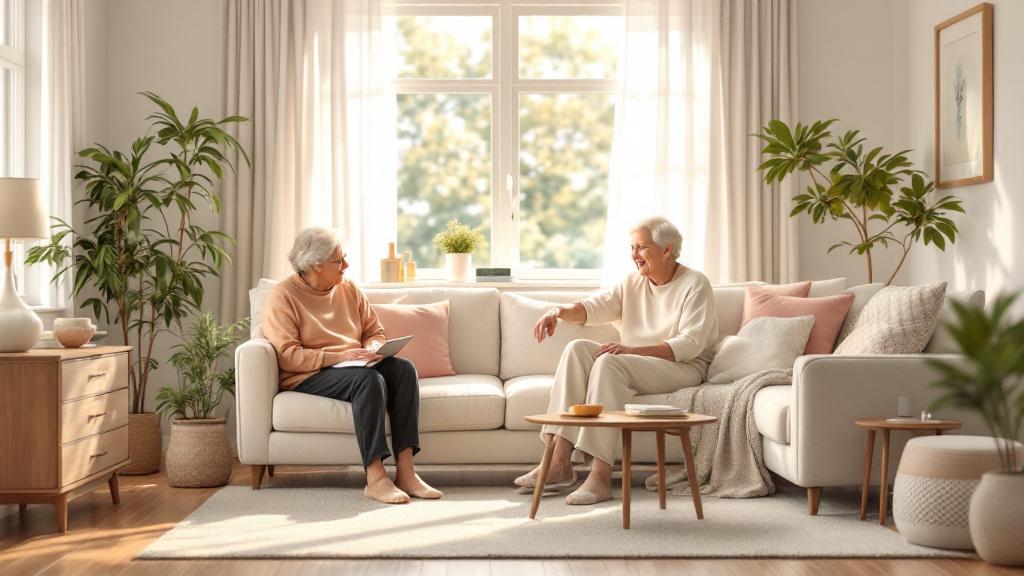The Benefits of Combining Therapies in In-Home Care Plans
Unlocking the Full Potential of In-Home Care with Combined Therapies

Exploring Multimodal Approaches in Senior Home Care
As the population ages, the demand for effective in-home care solutions intensifies. While traditional methods have focused on singular therapeutic or medical interventions, recent advancements highlight the benefits of a more integrative approach. The combination of therapies within home care plans not only addresses physical ailments but also encompasses mental and emotional health, offering a holistic solution tailored to individual needs. This article explores the multifaceted advantages of integrating complementary therapies in home care settings, specifically for seniors.
Enhancing Senior Well-being with Complementary Therapies

What are the benefits of integrating complementary therapies in in-home care for seniors?
Integrating complementary therapies in in-home care for seniors can significantly enhance their overall well-being by addressing both physical and mental health needs.
- Pain Relief and Mobility Improvement: Techniques such as acupuncture and massage therapy are effective in alleviating pain and improving mobility. These methods can help seniors reduce their reliance on medications, thus minimizing side effects associated with traditional pharmaceuticals.
- Emotional Health Support: Mindfulness meditation and music therapy can effectively combat depression and anxiety, which are common among older adults. These therapies promote emotional balance and foster social interaction, which is crucial for mental well-being.
- Physical Fitness and Social Connectivity: Activities like Tai Chi and yoga not only provide physical fitness but also encourage social connections. Engaging in these activities can enhance coordination, balance, and flexibility, reducing the risk of falls and maintaining independence.
- Tailored Care Plans: Implementing individualized care plans that incorporate complementary therapies ensures that seniors’ specific needs are met. This requires effective communication between healthcare providers and therapists to create person-centered care that is responsive to each senior's unique context.
Techniques and Approaches to Explore
Here’s a brief overview of some complementary therapies suitable for seniors:
| Technique | Benefits | Application |
|---|---|---|
| Acupuncture | Pain relief, improved mobility | Ideal for arthritis, chronic pain |
| Massage Therapy | Relaxation, reduced anxiety | Can alleviate tension and enhance mental health |
| Mindfulness Meditation | Decreased anxiety, improved focus | Regular sessions can foster emotional stability |
| Tai Chi | Improved balance, social interaction | Group classes promote physical fitness and community |
| Yoga | Enhanced flexibility, mindfulness | Adapted forms suitable for seniors' physical levels |
By recognizing the multifaceted benefits and engaging in appropriate complementary therapies, caregivers can significantly enhance the quality of life for seniors, providing holistic care that promotes both physical and emotional health.
The Synergy of Therapy and Medication in Mental Health

How does combining therapy and medication improve mental health treatment outcomes in home care?
Combining therapy and medication in home care enhances mental health treatment outcomes by addressing both the psychological and biological aspects of disorders. Research shows that therapies like cognitive behavioral therapy (CBT) combined with antidepressants lead to significantly better results for conditions such as depression and bipolar disorder.
This combination therapy increases response rates, with studies indicating improved quality of life and better functioning for those who receive both forms of treatment. For example, patients dealing with depression who engaged in combination therapy reported not only a reduction in depressive symptoms but also an improved overall quality of life. Additionally, this method reduces the chances of relapse, providing a more stable long-term outcome.
In the case of bipolar disorder, tailored therapy alongside medication has shown remarkable efficacy. Patients experienced greater treatment adherence and faster recovery rates, which contributed significantly to improving interpersonal interactions and daily functioning.
By enabling a more personalized treatment approach that considers individual clinical and psychosocial needs, combination therapy enhances the overall effectiveness of mental health care. Furthermore, the synergy between medication and therapeutic strategies allows patients to make the most of the coping skills they learn, promoting sustained recovery and well-being.
A Closer Look at Improved Outcomes
Here’s a brief overview of the advantages of combining therapy and medication across various mental health conditions:
| Condition | Benefits of Combination Therapy | Outcomes |
|---|---|---|
| Depression | Increased response rates | Better quality of life, reduced relapse |
| Bipolar Disorder | Enhanced treatment adherence, tailored therapy | Faster recovery rates, improved social interactions |
| Schizophrenia | Better treatment adherence, psychosocial support | Improved overall quality of life |
Overall, integrating therapeutic and pharmacological methods supports a more holistic approach to mental health treatment within home care, offering patients a pathway to more effective and meaningful recovery.
Creating Holistic In-Home Care Plans

What are the advantages of integrating various therapeutic approaches within in-home care plans?
Integrating various therapeutic approaches within in-home care plans offers significant advantages by creating a holistic treatment regimen that addresses the physical, emotional, and mental health needs of patients. This comprehensive care model promotes better communication and coordination among healthcare providers, leading to more effective treatment plans and improved patient outcomes.
By simplifying administrative processes, integrated care enables shared access to medical records, which enhances the patient experience and fosters higher satisfaction rates. This can also reduce healthcare costs in the long run. Additionally, personalized care planning ensures that treatment is tailored to individual needs, a critical factor for effectively managing chronic conditions.
Enhancing treatment plans with holistic care
Holistic care focuses on the whole person rather than just the illness. For example, in-home therapy programs can combine medication management with therapies that are personalized to the patient's hobbies and social interactions, enhancing their engagement and overall well-being. Regular health monitoring by caregivers can catch potential health issues early, providing timely interventions.
Coordination among healthcare providers
Coordination among healthcare providers is vital for successful integration. A well-structured shared care plan includes treatment goals, patient preferences, and ongoing communication about risks and updates. This collaborative approach ensures that all team members are aligned, improving care continuity and effectively addressing the multifaceted needs of patients, ultimately leading to better health outcomes.
Optimizing Elderly Outcomes with Combined Therapies

What is the impact of combined therapies on patient outcomes and care strategies for the elderly?
Combined therapies can significantly impact patient outcomes and care strategies for the elderly, demonstrating benefits across various health conditions. For instance, trials involving cognitive remediation and electrical neuromodulation suggest that integrating therapy for mental health can slow cognitive decline in older adults with a history of depression. This indicates that addressing mental health is crucial for mitigating dementia risks.
Lifestyle changes also play a vital role. Strategies that combine physical exercise, a balanced diet, and psychological support improve functionality among elderly individuals, especially in long-term care settings. Evidence shows that rehabilitation nursing paired with conservative therapy enhances recovery and reduces hospitalization time, particularly for patients suffering from compression fractures.
Examples of cognitive remediation and physical interventions
- Cognitive Remediation: Programs designed to enhance memory, attention, and problem-solving skills demonstrate effectiveness in slowing cognitive decline.
- Electrical Neuromodulation: This innovative approach is utilized to stimulate brain areas, potentially rejuvenating cognitive function.
- Physical Exercise: Regular engagement in tailored exercise regimens significantly improves mobility and balance, which is essential for reducing fall risks.
Improving health management for seniors
The evidence suggests that carefully implemented combined therapies lead to improved health management and quality of life for the elderly. Importantly, this highlights the need for inclusive clinical trials addressing diverse health needs within this demographic. By fostering a holistic approach that includes both physical and mental health considerations, healthcare providers can better serve the elderly population, ensuring they receive comprehensive and effective care.
The Role of Personalized Care in Home Healthcare
How does personalized care planning enhance in-home healthcare?
Personalized care planning enhances in-home healthcare by creating tailored interventions that address the unique needs, preferences, and medical histories of patients. This individualized approach leads to improved recovery rates and better management of chronic conditions, ultimately reducing hospital readmissions.
Additionally, personalized plans facilitate enhanced communication between patients and caregivers. This fosters trust, ensuring patients adhere to their treatment regimens. By involving patients in their care planning, these approaches promote active engagement, allowing individuals to take a commanding role in their health management.
Moreover, personalized care planning supports a holistic approach. It addresses not only the physical health of patients but also their emotional and social well-being. Such considerations contribute to increased patient satisfaction and an overall improvement in quality of life.
Enhancing in-home healthcare
In-home healthcare services, when combined with personalized care planning, provide patients with comprehensive support tailored to their specific needs. Caregivers can customize exercise regimens and meal plans based on individual capabilities, ensuring dietary and physical health requirements are met.
This personalized approach not only enhances the quality of care but also ensures that regular health monitoring is performed. By addressing potential health issues proactively, caregivers can avoid complications and enable timely medical interventions, which are critical for maintaining optimal patient wellness.
Improving patient communication and engagement
Effective personalized care planning also plays a significant role in refining patient communication and engagement. By creating clear, structured care plans that outline treatment goals and preferences, caregivers and patients can work together more effectively.
Engaging patients in this manner transforms the healthcare relationship into a collaborative partnership that encourages cooperation and shared decision-making, ultimately promoting better adherence to treatment and improved health outcomes.
Understanding Medicare's Role in Combining Therapies in Home Services
What are the benefits and methods of combining therapies in home health services, and does Medicare cover them?
Combining therapies in home health services has proven beneficial by allowing a coordinated approach to patient care. This method emphasizes collaboration among different healthcare professionals, leading to better rehabilitation outcomes. For instance, when skilled nursing, physical therapy, and occupational therapy are provided together, patients often experience effective recovery processes that cater to various aspects of their health.
Through evidence-based practices such as personalized care planning, home care becomes more holistic. By tailoring interventions to patient needs, caregivers can directly address multiple health issues simultaneously, enhancing their overall well-being and recovery rates.
Regarding Medicare coverage, several home health services are included under Parts A and B, providing considerable relief to eligible patients. Coverage typically consists of:
- Skilled Nursing Care - Personal care provided by certified professionals.
- Physical Therapy - Services aimed at improving mobility and independence.
- Occupational Therapy - Help with performing daily activities to regain functionality.
- Speech-Language Pathology - Treatments for speech and communication disorders.
To qualify for these services, patients must be homebound and require intermittent skilled care, which must be documented in a physician-approved plan of care. Importantly, home health aide services can also be covered but only when associated with skilled services.
Eligibility and documentation requirements
To ensure access to at-home therapeutic services through Medicare, the following criteria must be met:
- Homebound Status: Patients should have difficulty leaving their home without assistance.
- Skilled Care Necessity: Intermittent skilled nursing or therapy must be required.
- Medicare-Certified Agency: Services must be rendered by a Medicare-approved home health agency.
- Physician'S Order: A documented plan of care needs to be established by a physician.
These requirements help streamline care access and ensure patients receive comprehensive, coordinated services that significantly contribute to their recovery and overall quality of life.
Innovations in In-Home Mental Health Care
Collaborative care model
Collaborative care is an evidence-based approach shown to improve outcomes for mental health disorders. A systematic review of 150 programs revealed that while only 42% included personalized care planning or shared decision-making, these components are vital to enhancing patient engagement and treatment efficacy.
Personalized care planning and shared decision-making
Personalized care planning emphasizes a patient-centered approach, where care is tailored to individual needs and preferences. This model involves a diverse care team and encourages shared decision-making, allowing patients to participate actively in their treatment paths. Though vital, consistent implementation across collaborative care programs is currently lacking.
Evidence-based outcomes
Research indicates significant benefits of integrated in-home mental health services. For example, patients receiving personalized care at home reported better adherence to medication and a greater quality of life. By integrating healthcare services with essential daily living support—both medical and non-medical—home care can substantially enhance overall well-being for seniors and individuals with mental health challenges.
Virtual Care: Bridging Gaps in Home Healthcare
Benefits of virtual visits
Virtual visits have transformed the landscape of home healthcare, offering significant benefits such as increased accessibility and flexibility. Patients can connect with healthcare providers right from their homes, minimizing the need for travel, especially for those in rural or underserved areas. This leads to timely medical interventions that may prevent complications or exacerbation of health conditions.
Cost-effectiveness and patient engagement
Moreover, virtual visits enhance cost-effectiveness by reducing transportation costs and allowing providers to manage larger patient loads efficiently. Patients appreciate the convenience of virtual visits, which encourages them to maintain engagement with their treatment plans. This increased engagement fosters better adherence to prescribed therapies and overall health monitoring.
Improving access and monitoring
Virtual visits also facilitate improved patient monitoring. Healthcare providers can regularly check in on patients’ conditions and detect any early signs of complications. This proactive approach is particularly vital for individuals managing chronic diseases, ensuring prompt interventions and better health outcomes. Ultimately, the integration of virtual care into home healthcare enriches the patient experience and encourages a comprehensive, team-based approach to health management.
Economic and Social Impacts of In-Home Care

Cost Savings with In-Home Therapies
In-home care has been shown to be less expensive, often providing significant cost savings compared to traditional healthcare settings. Services such as home health care are not only more convenient but have also proven to be as effective for various medical conditions. Costs are further reduced when copays for in-home therapy visits are eliminated, making essential care more accessible for patients.
Improving Social Connections
In-home caregivers contribute greatly to enhancing social connections for seniors. They foster human connections by engaging clients in social activities and hobbies, reducing feelings of isolation. Companionship provided by caregivers is essential for mental and emotional wellbeing, addressing loneliness that many seniors face.
Enhancing Patient Adherence and Satisfaction
When therapy is delivered at home, patients demonstrate better adherence to their care plans. This adherence is crucial for achieving positive health outcomes and overall patient satisfaction. Home-based services not only improve health-related quality of life but also empower individuals by respecting their routines and preferences, thus promoting a holistic model of care.
| Aspect | In-Home Care | Traditional Care |
|---|---|---|
| Cost | Less expensive, potential savings | Higher costs, includes transportation |
| Social Connection | Fosters engagement and reduces isolation | Limited social interaction |
| Patient Adherence | Higher adherence and satisfaction | Variable adherence levels |
In summary, in-home care is not just a cost-effective solution but plays a vital role in enriching the social lives and healthcare experiences of patients.
Toward a Comprehensive In-Home Care Model
In-home care that leverages the integration of multiple therapies has shown promising results in optimizing both physical and mental health outcomes for seniors. By tailoring care plans to involve complementary therapies, medication, and cutting-edge virtual solutions, healthcare providers can transform the home into a versatile healing environment. The potential for cost savings, coupled with improved patient satisfaction and adherence, highlights the significance of these integrated methods. As we continue to unravel the complexities of aging and chronic disease management, a multi-disciplinary approach in home care stands out as a cornerstone for sustainable, patient-centered healthcare solutions.
References
- Benefits of Combining Medications and Therapy - Highland Hospital
- Personalized care planning and shared decision making in ...
- Benefit innovation: Exploring a new care model with in-home, in ...
- Integrating Personalized Care Planning into Primary Care
- Benefits of In-home Care for Mental and Physical well being
- Impact of Home Care Services on Patient and Economic Outcomes
- How Home Health and Home Care Can Work Together
- Home Health Services Coverage - Medicare
- Incorporating Virtual Visits into the Home Health Plan of Care

How to Plan for Long-Term Home Care Services

How Home Team Helps Families Make Informed Care Decisions

How Home Team's Caregivers Provide Peace of Mind for Families



